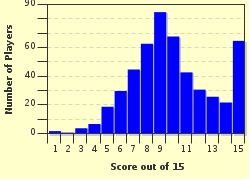Quiz Answer Key and Fun Facts
1. Ornithogallum umbellatum is the botanical name of a plant referred to in the second book of Kings as "dove's dung" (a literal translation of the Latin name). Contemporary gardeners more likely know this plant, with its sprays of white flowers, by this more euphonious and charming name, which is derived from the Gospel of Matthew.
2. Roses are occasionally mentioned in scripture, notably in Isaiah 35:1 ("...and the desert shall rejoice and blossom as the rose") and in the Song of Solomon 2:1 ("I am the Rose of Sharon"). Most contemporary botanists agree that the flower in question is not actually the rose, as we know it, but this bulbous flower, native to the Holy Land.
3. In the Gospel of Matthew (6:28-29), Jesus refers to the "lilies of the field", remarking that "...they toil not, neither do they spin: And yet I say unto you, that even Solomon, in all his glory, was not arrayed like one of these." The "lilies" referenced in this passage may be any one of a variety of plants (including members of the Lily family), or a combination thereof. Which of these plants could NOT be considered one of the Biblical "lilies of the field", since it is not indigenous to the Holy Land?
4. The Song of Solomon (4:14) mentions a multitude of fragrant spices, including cinnamon, calamus, myrrh, and saffron. The last of these- saffron- is derived from this flower, varieties of which bloom in both the fall and in the early spring.
5. In the book of Numbers (11:7), the manna which miraculously appeared to feed the Israelites in the desert is compared to the seed (or, more properly, the dried fruit) of this culinary herb.
6. A passage in the book of Exodus (37:17-18) describes the creation of the seven-branched candlestick known as the menorah. Most Biblical scholars believe that the shape of the menorah was derived from the Judean variety of this perennial herb, whose Latin name means "health", and which has been widely used for centuries as both a medicinal and culinary herb.
7. Frankincense and Myrrh are mentioned numerous times in the Old Testament, and along with gold, comprise the gifts presented by the Magi to the child Jesus. Frankincense is derived from trees of the genus Boswellia, and Myrrh from plants of the genus Commiphora. From what part of these plants is their characteristic fragrance principally derived?
8. Hyssop is a plant mentioned several times in Scripture as being used for ritual purification, notable in Psalm 51:7- "Purge me with hyssop, and I shall be clean; wash me, and I will be whiter than snow." This may refer to the plant known in Europe and America as hyssop (Hyssopus Officinalis), but many scholars and botanists believe that it is a version of this culinary herb.
9. In the Book of Numbers (11:5) the Israelites complain of hunger in the desert, and recall that, while slaves in Egypt, they at least had enough to eat. Among other things, they mention these vegetables and fruits, which were available in abundance in Egypt.
10. This fruiting tree is mentioned numerous times in Scripture. In Genesis 3:7 Adam and Eve are described as making themselves aprons from its leaves to cover their nakedness. In the gospels of Matthew and Mark, Jesus is described as cursing one upon finding it to be unfruitful, causing it to presently wither and die.
11. In Genesis 8:8-11, Noah twice sends a dove from the ark in search of dry land. When the dove returns the second time, it bears in its beak a leaf from this fruiting tree, indicating that the waters of the flood had begun to recede. For centuries, the image of a dove carrying a branch of this tree has been an emblem of peace.
12. The book of Exodus- 28:33-34- specifies that the hem of priestly robes should be embroidered with images of this fruit, alternating with golden bells.
13. References to apples and to apple trees in Scripture are numerous. However, since trees of the genus "Malus Pumila" have only been introduced to the Holy Land comparatively recently, many scholars believe that the apple mentioned in scripture is actually this fruiting tree, whose botanical name is "Prunus Armeniaca".
14. The inside walls and floor planks of the Temple of Solomon, as well as Solomon's chariot, were made of the fragrant wood of this tree, which has long been associated with Lebanon.
15. According to all four Gospels, Jesus was greeted upon his entry into Jerusalem before the Passion by crowds waving fronds from this tree. In many Christian churches, it has long been traditional to bless and distribute these fronds at the beginning of Holy Week.
Source: Author
jouen58
This quiz was reviewed by FunTrivia editor
CellarDoor before going online.
Any errors found in FunTrivia content are routinely corrected through our feedback system.

